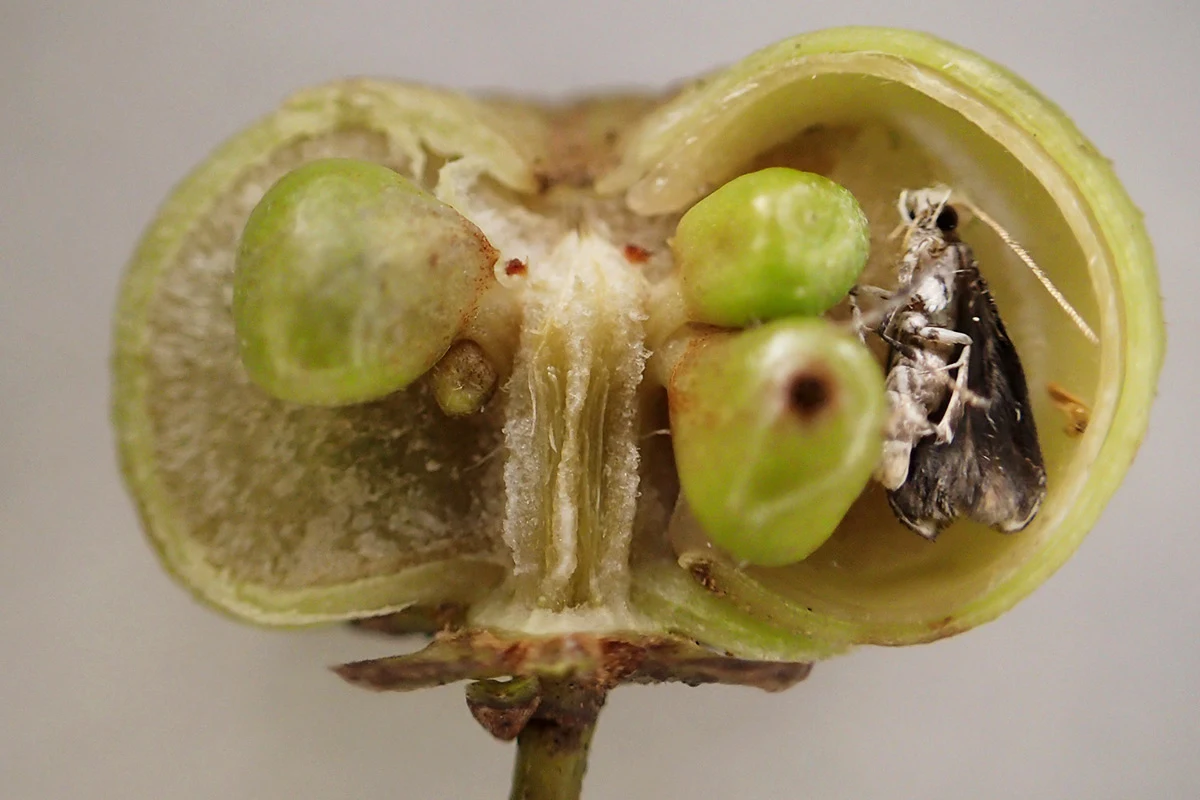 |
| Epicephala lanceolaria moth inside the fruit of Glochidion lanceolarium Credit: Shi-Xiao Luo, et al. |
Who ever imagined that selfish genes inevitably lead to mutually destructive competition? Well, by and large, of course, these are the same people who argue that atheist societies will be lawless hell-holes full of rapists and cutthroat murderers with no-one having any reason to be anything other than utterly selfish. Reality was never their strong point.
The rebuttal is of course the same: no such system could evolve because mutual destruction and selfishness produce fewer, not more, descendants. The fact that we observe neither of these outcomes in reality is evidence for the evolutionary process.
Regular readers will be aware that how selfish genes create cooperative organisms is an on-going theme of mine but this example from New Scientist is a new one to me, and a rather nice example too. It concerns the relationship between the leafflower trees of south-east China, of the genus Glochidion and the leafflower moths of the genus Epicephala.
These two species have evolved an especially close system of mutual dependency with each species of tree having its own specific species of polinating moth. The trees produce male and female flowers in April and May but, during the daytime, they do nothing to attract other potentially pollinating insects, no scent, no nectar. But at night they produce a scent which seems to be irresistible to female leafflower moths which go first to male flowers and load their proboscis with pollen; they then go to a female flower and transfer the pollen to the stigma. Then they lay one egg in the flower.
By the time the egg hatches a few months later, the fruit will have developed and provided a safe environment for the developing grub which eats a coup of the seeds, leaving plenty more. With most species, the normal course of events is that the grub matures until ready to pupate; it then bores its way out of the fruit, drops to the forest floor and pupates in the soil.
But one species has taken this a stage further: E. lanceolaria still lays its egg in the fruit in April and May but the species it lays them in, G. lanceolarium, keeps its fruits dormant until the following January, at which point the egg hatches. With such a short time to mature in time for the next flowering, the grubs pupate and become adults within the fruit. The fruits then mature, releasing their captives just in time for the new batch of flowers.
The trees coordinate the whole thing, so ensuring they have an immediate supply of pollinating moths ready to go to work.
Two unrelated genuses from very different branches of the evolutionary tree have co-evolved since the evolution of flowering plants in the late cretaceous between 100 and 125 million years ago, just have so many of the insect-flowering plant relationships. This may well have started off as a parasitic relationship with the moth laying it's eggs in the flowers simply to provide food for their young. At every step of the way from then on as this system evolved there would have been a clear advantage to one or both species but it was in neither species interest to resist or oppose the other. For example, it would have been to neither species benefit for the moth to lay several eggs, so consuming all the seeds in the fruit; it would have been in neither species interest for the eggs of E. lanceolaria to hatch at the 'normal' time for other species, and it would have been in neither species interest for G. lanceolarium to release the moth too early or too late.
Perhaps a creationist would explain how this system could evolve if, as they claim, selfish genes create selfish organisms. More to the point, perhaps, maybe a creationist would explain why a process which selects for whatever produces most descendants in the long term would not evolve this sort of mutually beneficial cooperative system.
Perhaps too a creationist would explain why any intelligent designer would devise such a complicated method for getting the flowers of the Glochidion genus pollinated, assuming it had for reasons unknown, decided to design flowers as the sexual organs of a major group of plants in the first place.
'via Blog this'

No comments:
Post a Comment
Obscene, threatening or obnoxious messages, preaching, abuse and spam will be removed, as will anything by known Internet trolls and stalkers, by known sock-puppet accounts and anything not connected with the post,
A claim made without evidence can be dismissed without evidence. Remember: your opinion is not an established fact unless corroborated.